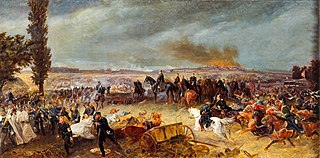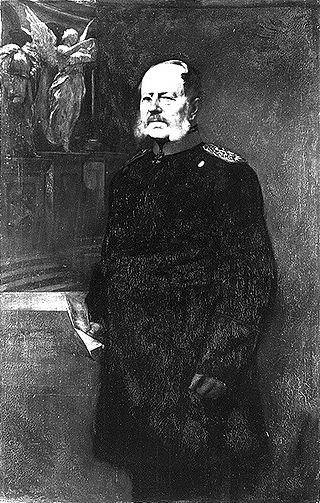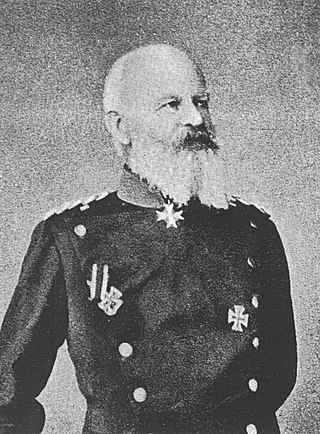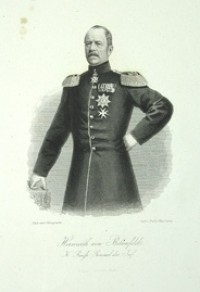
The Battle of Königgrätz was the decisive battle of the Austro-Prussian War in which the Kingdom of Prussia defeated the Austrian Empire. It took place on 3 July 1866, near the Bohemian city of Hradec Králové and village of Sadová, now in the Czech Republic. It was the single largest battle of the war, and the largest battle in the world since the Battle of Leipzig in 1813.

Karl Eberhard Herwarth von Bittenfeld was a Prussian Generalfeldmarschall. He served in many military conflicts throughout the 19th century and was given major commands throughout each conflict.
The 13th Division was a unit of the Prussian/German Army. It was formed in November 1816 in Münster in Westphalia as a troop brigade and became the 13th Division on September 5, 1818. The division was subordinated in peacetime to the VII Army Corps. The division was disbanded in 1919 during the demobilization of the German Army after World War I. The division was recruited primarily in the Prussian Province of Westphalia and two small principalities in the Westphalian region, Lippe-Detmold and Schaumburg-Lippe.
The 2nd Division was a unit of the Prussian/German Army. It was formed in Danzig in March 1816 as a Troop Brigade (Truppen-Brigade). It became the 2nd Division on September 5, 1818. In 1890, the headquarters of the division was relocated to Königsberg, then the capital of East Prussia. In 1899, the headquarters was moved to Insterburg, further inland and closer to the border with the Russian Empire. From the latter's formation in 1820, the division was subordinated in peacetime to the I Army Corps. The 2nd Division was disbanded in 1919 during the demobilization of the German Army after World War I.
The 3rd Division was a unit of the Prussian/German Army. It was formed in Stettin in May 1816 as a Troop Brigade (Truppen-Brigade). It became the 3rd Division on September 5, 1818. From the corps' formation in 1820, the division was subordinated in peacetime to the II Army Corps. The 3rd Division was disbanded in 1919 during the demobilization of the German Army after World War I.
The 9th Division was a unit of the Prussian/German Army. It was formed in Glogau in November 1816 as a brigade, became the 10th Division on September 5, 1818, and was renumbered the 9th Division on February 28, 1820. The division was subordinated in peacetime to the V Army Corps. The division was disbanded in 1919 during the demobilization of the German Army after World War I. The division was recruited primarily in the Province of Silesia, primarily in Lower Silesia.

The 10th Division was a unit of the Prussian/German Army. It was formed in Posen in November 1816 as a brigade, became the 9th Division on September 5, 1818, and was renumbered the 10th Division on February 28, 1820. The division was subordinated in peacetime to the V Army Corps. The division was disbanded in 1919, during the demobilization of the German Army after World War I. The division was recruited primarily in the Province of Posen.
The 11th Division was a unit of the Prussian/German Army. It was formed in Breslau in November 1816 as a brigade, and became the 11th Division on September 5, 1818. The division was subordinated in peacetime to the VI Army Corps. The division was disbanded in 1919 during the demobilization of the German Army after World War I. The division was recruited primarily in the Province of Silesia, mainly in the region of Lower Silesia.
The 14th Division was a unit of the Prussian/German Army. It was formed in November 1816 in Trier as a troop brigade and became the 14th Division on September 5, 1818, also relocating its headquarters to Düsseldorf. The division was subordinated in peacetime to the VII Army Corps. The division was disbanded in 1919 during the demobilization of the German Army after World War I. The division was recruited in the Prussian Province of Westphalia and the Rhine Province, primarily in the densely populated Lower Rhine region.
The 15th Division was a unit of the Prussian/German Army. It was formed as the 16th Division on September 5, 1818, in Cologne from the 4th Brigade of the Army Corps in France. It became the 15th Division on December 14, 1818. The division was subordinated in peacetime to the VIII Army Corps. The division was disbanded in 1919 during the demobilization of the German Army after World War I. It was recruited in the densely populated Prussian Rhine Province, mainly in the Lower Rhine region.
The 16th Division was a unit of the Prussian/German Army. It was formed as the 15th Division on September 5, 1818, in Koblenz from a troop brigade. It became the 16th Division on December 14, 1818, and moved its headquarters to Trier. The division was subordinated in peacetime to the VIII Army Corps. The division was disbanded in 1919 during the demobilization of the German Army after World War I. It was mainly recruited in the densely populated Prussian Rhine Province, mainly along the Rhine and the cities and towns along the Moselle River.
The 23rd Division, also known as the 1st Division No. 23 was a unit of the Saxon and then Imperial German Army. The division was headquartered in Dresden. The division was subordinated in peacetime to the XII Army Corps.
The 31st Division was a unit of the Prussian/German Army. It was formed on March 20, 1871, and was headquartered in Straßburg until 1912, and then in Saarbrücken. The division was subordinated in peacetime to the XV Army Corps until 1912, and then to the XXI Army Corps. The division was disbanded in 1919 during the demobilization of the German Army after World War I. The division was recruited primarily in the southern part of the Rhine Province, but during World War I also drew replacements from Westphalia.
The 42nd Division was a unit of the Prussian/German Army. It was formed on October 1, 1912, and was the last regular division created in the Imperial German Army. It was headquartered in Saarburg in Lothringen. The division was subordinated in peacetime to the XXI Army Corps. The division was disbanded in 1919 during the demobilization of the German Army after World War I. The division was primarily recruited in the Rhine Province and the Province of Westphalia, as the German population in Alsace-Lorraine was insufficient to fill the division.
This is the German Army order of battle on the outbreak of World War I in August 1914.
The following units and commanders took part in the Battle of Königgrätz on July 3, 1866. Compiled from the Prussian Army's Official History of the war.
The First Army was a Prussian formation during the Austro-Prussian War. Being a wartime organization of the Prussian Army; it afterwards was demobilized.
The Second Army was a formation of the Prussian Army during the Austro-Prussian War. Being a wartime formation, afterwards the field army was demobilized.

Theodor Alexander Viktor Ernst von Schoeler (1807-1894) was a Prussian General of the Infantry who served in the Austro-Prussian War and the Franco-Prussian War through several battles.

Friedrich Adrian Herwarth von Bittenfeld was a Prussian General of the Infantry. He was known for being the younger brother of Field Marshal of Eberhard Herwarth von Bittenfeld and commanding the 4th Division during the Austro-Prussian War.




